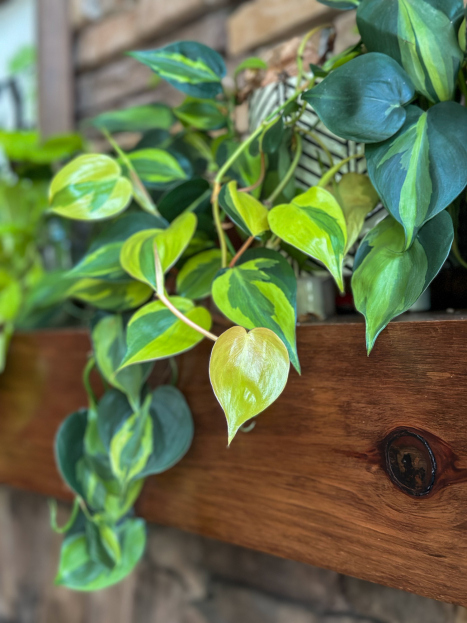
Scindapsus ‘Brazil’ is a rare and stunning variety of Scindapsus pictus, admired for its unique variegation that features bright lime-green and deep green patterns. This houseplant is not only beautiful but also easy to care for, making it a great choice for both beginners and experienced plant enthusiasts. Whether you want to grow it in a hanging basket or let it climb a moss pole, Scindapsus ‘Brazil’ will thrive with the right care.
Here’s everything you need to know to keep your Scindapsus ‘Brazil’ healthy and vibrant!
Scindapsus ‘Brazil’ thrives in bright, indirect light. A spot near an east- or north-facing window provides the ideal lighting conditions for this plant. Too much direct sunlight can scorch the leaves, causing brown spots or faded colors, while too little light may cause the variegation to diminish and slow the plant’s growth. If your plant starts producing more solid green leaves, it may need more light, so consider moving it closer to a well-lit area or using a grow light.
Scindapsus ‘Brazil’ prefers a balanced watering routine, where the soil is allowed to dry out slightly between waterings. Water your plant when the top 1-2 inches of soil feel dry to the touch. Be sure to use room-temperature, filtered, or distilled water to avoid any chemicals that may cause leaf damage. Reduce watering in the fall and winter when growth slows. Overwatering can lead to root rot, so always check the soil before adding more water. If the leaves begin to yellow and feel mushy, it’s a sign of excess moisture.
For optimal growth, Scindapsus ‘Brazil’ needs well-draining soil that retains some moisture but does not stay soggy. A good potting mix includes two parts indoor potting soil, one part perlite or pumice for aeration, and one part orchid bark or coconut coir for drainage. Always use a pot with drainage holes to prevent standing water. Repot the plant every two to three years or when the roots begin to grow out of the pot’s drainage holes.
As a tropical plant, Scindapsus ‘Brazil’ thrives in warm temperatures and moderate to high humidity. Keep it in an environment with temperatures between 65-85°F (18-29°C), and avoid exposing it to cold drafts, air conditioners, or heaters. If your indoor air is dry, especially during winter, consider misting the leaves occasionally, placing a humidity tray nearby, or using a humidifier to maintain a humidity level of 50-70%. If the edges of the leaves start turning crispy, this is often a sign that the air is too dry.
Scindapsus ‘Brazil’ is a relatively low-maintenance plant, but fertilizing can help encourage lush growth and maintain its vibrant variegation. Feed your plant once a month during the spring and summer with a balanced liquid houseplant fertilizer diluted to half strength. Avoid fertilizing in the fall and winter when growth slows. Be careful not to over-fertilize, as this can lead to salt buildup in the soil, which may cause brown leaf tips.
Pruning helps keep Scindapsus ‘Brazil’ full and bushy. Trim any leggy vines to encourage compact growth and remove any damaged or yellowing leaves to keep the plant looking fresh. Wipe the leaves occasionally with a damp cloth to remove dust, which can improve photosynthesis. If you want a fuller, bushier look, pinching back the tips of new growth will promote branching.
Scindapsus ‘Brazil’ is easy to propagate through stem cuttings. Simply cut a healthy vine just below a node (where a leaf meets the stem) and place the cutting in water or directly in moist soil. Keep the cutting in bright, indirect light and maintain humidity. Roots should develop within two to four weeks, after which you can transplant the cutting into a pot. Propagation is a great way to expand your collection or share this rare plant with friends!
If the leaves start turning yellow, this is usually a sign of overwatering. Check the soil moisture and ensure proper drainage to prevent root rot. If the leaves begin curling, the plant may be underwatered or experiencing low humidity, so adjust your watering routine and humidity levels as needed. If the variegation starts fading and leaves become more green, the plant may not be receiving enough light. Moving it to a brighter location can help restore its vibrant color. Occasionally, pests such as mealybugs, spider mites, or aphids may appear, but wiping the leaves with insecticidal soap or neem oil will help keep pests under control.
Unfortunately, Scindapsus ‘Brazil’ is toxic to pets if ingested. Like other Scindapsus plants, it contains calcium oxalate crystals, which can cause mouth irritation, drooling, and digestive issues in cats and dogs. Keep it out of reach of pets to prevent any accidental nibbling.